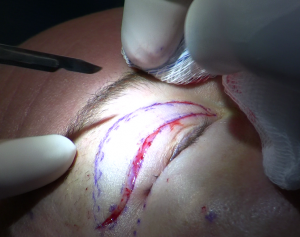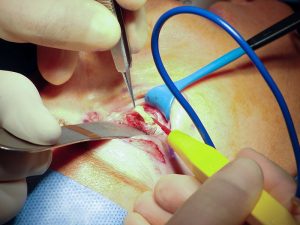Blepharoplasty (“eyelid” + “to form”) is the plastic surgery operation for correcting defects, deformities, and disfiguring of the eyelids; and for aesthetically modifying the eye region of the face.
With the excision and the removal, or the re-positioning (or both) of excess tissues, such as skin and adipocyte fat, and the reinforcement of the corresponding muscle and tendon tissues, the blepharoplasty procedure resolves functional and cosmetic problems of the periorbita, which is the area from the eyebrow to the upper portion of the cheek.
The operative goals of a blepharoplastic procedure are the restoration of the correct functioning to the affected eyelid(s), and the restoration of the aesthetics of the eye-region of the face, which are achieved by eliminating excess skin from the eyelid(s), smoothing the underlying eye muscles, tightening the supporting structures, and resecting and re-draping the excess fat of the retroseptal area of the eye, in order to produce a smooth anatomic transition from the lower eyelid to the cheek.
In an eye surgery procedure, the usual correction or modification (or both) is of the upper and the lower eyelids, and of the surrounding tissues of the eyebrows, the upper nasal-bridge area, and the upper portions of the cheeks, which are achieved by modifying the periosteal coverings of the facial bones that form the orbit (eye socket). The periosteum comprises two-layer connective tissues that cover the bones of the human body: the external layer of networks of dense, connective tissues with blood vessels, and the internal, deep layer of collagenous bundles composed of spindle-shaped cells of connective tissue, and a network of thin, elastic fibers.
Sequentially, lower eyelid blepharoplasty can successfully address the anatomic matters of excess eyelid skin, slackness of the eye-muscles and of the orbital septum (palpebral ligament), excess orbital fat, malposition of the lower eyelid, and prominence of the nasojugal groove, where the orbit (eye socket) meets the slope of the nose.


